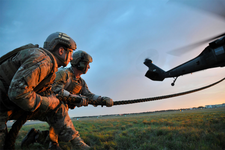Aquitaynian Special Operations Command: Difference between revisions
m (1 revision imported) |
mNo edit summary |
||
| (6 intermediate revisions by the same user not shown) | |||
| Line 1: | Line 1: | ||
{{Region icon Astyria}} | |||
{{Infobox military unit | {{Infobox military unit | ||
|unit_name= Aquitaynian Special Operations Command<br />{{small|(SOCOM)}} | |unit_name= Aquitaynian Special Operations Command<br />{{small|(SOCOM)}} | ||
|image= | |image= [[Image:SF-3.png|225px]] | ||
|caption= Aquitaynian Special Operations Command Emblem | |caption= Aquitaynian Special Operations Command Emblem | ||
|start_date={{start date and age|1971|03|22}} | |start_date={{start date and age|1971|03|22}} | ||
| Line 53: | Line 54: | ||
Today, the 3rd Battalion, 91st Special Infantry Regiment is still deployed to the Western Tundra on a new mission. They are currently operating against the [[Holy Theocracy of Lorecia]], a terrorist organization operating within the Western Tundra. They are also currently being utilized by the coalition for training and support as well as direct action missions. Additional special forces units from the air force and army have also been deployed to the region, with Special Infantry Service soldiers providing training and direction for local secular rebel groups fighting the HTL. Currently, the Ministry of Defense refuses to disclose how many troops are currently deployed to the Western Tundra, but do acknowledge that "troops have been engaged in combat with the Holy Theocracy of Lorecia". The Ministry of Defense has disclosed, additionally, that Aquitaynian Special Forces components of SOCOM are being used for a wide range of special operations capabilities and necessities. | Today, the 3rd Battalion, 91st Special Infantry Regiment is still deployed to the Western Tundra on a new mission. They are currently operating against the [[Holy Theocracy of Lorecia]], a terrorist organization operating within the Western Tundra. They are also currently being utilized by the coalition for training and support as well as direct action missions. Additional special forces units from the air force and army have also been deployed to the region, with Special Infantry Service soldiers providing training and direction for local secular rebel groups fighting the HTL. Currently, the Ministry of Defense refuses to disclose how many troops are currently deployed to the Western Tundra, but do acknowledge that "troops have been engaged in combat with the Holy Theocracy of Lorecia". The Ministry of Defense has disclosed, additionally, that Aquitaynian Special Forces components of SOCOM are being used for a wide range of special operations capabilities and necessities. | ||
===Global presence=== | ===Global presence=== | ||
[[Image:SFAk47.jpg|thumb|right|225px|A sailor from a [[Naval Special Operations]] Team is seen training for | [[Image:SFAk47.jpg|thumb|right|225px|A sailor from a [[Naval Special Operations]] Team is seen training for arctic operations.]] | ||
In 2014, Special Operations Command units and or assets were deployed in over 60 countries throughout the world. This is compared to roughly 34 in the beginning of 2003. A SOCOM spokesman was quoted as saying in 2011, just after the [[South Lorecian War]], that "SOCOM hopes to have assets in over 100 countries by the end of 2020, providing a large network of training, capability, and valuable resources." The push for an expansion of SOCOM's reach coincides with a larger expansion of Aquitaynian military presence and power projection throughout [[Astyria]] and the rest of the world. Their reach expanded greatly after the 2010 South Lorecian War, where they were vital to the success of the campaigns against [[Earent]]. SOCOM has been active in every major conflict in Astyria since then, under the "no war, no questions" motto - an ethos that drives SOCOM to be as informed as possible on every conflict going on not only throughout Astyria, but the world. | In 2014, Special Operations Command units and or assets were deployed in over 60 countries throughout the world. This is compared to roughly 34 in the beginning of 2003. A SOCOM spokesman was quoted as saying in 2011, just after the [[South Lorecian War]], that "SOCOM hopes to have assets in over 100 countries by the end of 2020, providing a large network of training, capability, and valuable resources." The push for an expansion of SOCOM's reach coincides with a larger expansion of Aquitaynian military presence and power projection throughout [[Astyria]] and the rest of the world. Their reach expanded greatly after the 2010 South Lorecian War, where they were vital to the success of the campaigns against [[Earent]]. SOCOM has been active in every major conflict in Astyria since then, under the "no war, no questions" motto - an ethos that drives SOCOM to be as informed as possible on every conflict going on not only throughout Astyria, but the world. | ||
| Line 65: | Line 66: | ||
===Marines=== | ===Marines=== | ||
===Air Force=== | ===Air Force=== | ||
==List of SOCOM Combatant commanders== | ==List of SOCOM Combatant commanders== | ||
| Line 83: | Line 85: | ||
|22 March 1971 | |22 March 1971 | ||
|18 June 1976 | |18 June 1976 | ||
|{{ | |{{age in days|22 March 1971|18 July 1976}} days | ||
|- | |- | ||
|} | |} | ||
{{Aquitaynian Armed Forces}} | |||
[[Category:Aquitayne]][[Category:Astyria]][[Category:Military Units of Aquitayne]][[Category:Military Units of Astyria]][[Category:Special Forces]][[Category:Military Organizations]] | [[Category:Aquitayne]][[Category:Astyria]][[Category:Military Units of Aquitayne]][[Category:Military Units of Astyria]][[Category:Special Forces]][[Category:Military Organizations]] | ||
Latest revision as of 15:57, 3 March 2024
| Aquitaynian Special Operations Command (SOCOM) | |
|---|---|
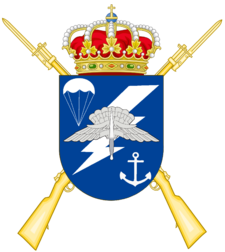 Aquitaynian Special Operations Command Emblem | |
| Founded | March 22, 1971 |
| Country | |
| Type | Functional Combatant Command Special operations |
| Role | Provide fully capable special operations forces to defend Aquitayne and the United Kingdom and its interests and plan and synchronize operations against terrorist networks |
| Size | Entire command: 32,000 Headquarters staff: 1,850 |
| Part of | Ministry of Defense |
| Headquarters | Fort Aguilar, Eurel, Aquitayne |
| Nickname(s) | AQSOCOM, SOFCOM, SOCOM |
| Engagements | Operation Island Serpent South Lorecian War Greater Insula Feran Conflict 2013 Invasion of Pangus Western Tundra Crisis |
| Commanders | |
| Current commander | Grand Field Marshal Victor Petrov, HMA |
The Aquitaynian Special Operations Command (AQSOCOM, SOFCOM, or SOCOM) is the Unified Combatant Command charged with overseeing the various Special operations component commands of the Army, Navy, Royal Marines, and Air Force of the Aquitaynian Armed Services. The command is part of the Ministry of Defense and is directly commanded by the Defense Advisory Council, and likewise the King, Samuel Reich.
SOCOM conducts several covert and clandestine operation such as direct action, special reconnaissance, counter-terrorism, foreign internal defense, unconventional warfare, psychological warfare, civil affairs, and counter-narcotics operations. Each branch has their own independent special operations command structure that is fully capable of acting on its own, independent of any other service. When operations call for the use of forces from two or more service branches, the command and control for that operation is given to SOCOM as the joint component command of the operation.
History
Second Great Astyrian War
Operation Island Serpent
In response to the ongoing communist revolution in Pangus, Aquitayne, with support of other EATA nations intervened in the country in an attempt to stop the revolution from succeeding in their goals. Aquitaynian intervention came in the form of various special operations forces. These forces, however, had not seen real combat since the end of the Second Great Astyrian War, and their combat veterans had long since retired. This lead to an overestimation by their command in the units abilities to achieve victory over an enemy which was largely seen as inferior, having lacked true military training. Even still, in the first days of combat, Aquitaynian forces were largely unsuccessful in their attempts to break through to the capital, Corvus. It was here that the Army general staff placed their faith in the special forces units they had deployed. The units initially faced hard combat with the communist rebels, and found it difficult to advance.
Large casualties and failures in critical mission goals on the part of the army's special forces units lead many to believe they had become totally incompetent. This wasn't helped by the fact that communications problems had arisen in relation to the other units that were operating in-theater. The lack of coordination in their independent operations and use of different radio frequencies eventually lead to two Aquitaynian units engaging one another in thick brush. The combat lasted for well over 2 hours, and wasn't recognized as blue-on-blue fire until both units had called in air strikes on the other's location, leading a radio operator to alert his command to the situation. Immediately, both units were notified and the fighting ceased, but by the end of the combat over 8 Aquitaynians were dead from both sides. This engagement and failure on all fronts of the special forces' role in the invasion lead the Ministry of Defense to seriously reconsider the role and organization of the Aquitaynian special forces community.
Formation
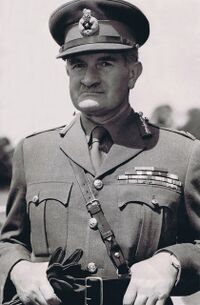
In the aftermath of the Pangus Revolution, which saw a complete failure in the nature the government and the military wanted the Aquitaynian special forces units to function was seen, the Ministry of Defense acknowledged changes needed to be made. In In 1967, Ser Richard Cassian, then a Senior Field Marshal, was in command of the Royal Army's 19th Special Infantry Division, a unit that comprised the entirety of the Army's special forces units. He had been appointed after his predecessor had allowed the failures in Pangus to diminish the reputation of the Aquitaynian military and special forces as a whole. His rank was much higher than the position required necessary, but he was seen largely by the rest of the general staff as the only person capable of reforming the Division and re-establishing Aquitayne's reputation on the global stage.
Cassian's reformation of the Army's special forces would unfurl in three major developments. The first was a complete restructuring of the different units into a smaller, compact force that encompassed all areas of the other units into individual fighting forces. These Special Infantry Service units would later become known as Special Infantry Regiments, with battalions operating on their own in-theater. This restructuring ultimately slashed the special forces division in half, and ultimately angered many of his superiors. They believed that they had assigned him to fix the problem, not diminish the army's fighting capabilities. The second phase of his solution would solve this concern.
The second part of Cassian's model was to reform the selection process for the special forces. He designed a process in which a pre-selection had to be completed before actual training for the special forces could begin. Prior to this, applicants would simply arrive at the command's training school and attempt to pass it, which clogged the system with ill-equipped applicants that were not ready, or able, to be there. The pre-selection training allowed Cassian to slim down the intake of new soldiers while retaining only those soldiers who were mentally and physically capable of being there. The final part of Cassian's three-party reformation of the special infantry services was to create a unified command to encompass all of the special forces units across the military.
The creation of the Joint Special Operations Command (JSOC) would be Cassian's greatest achievement in the military. He provided the Ministry of Defense with a comprehensive plan, in wake of the Pangus debacle, on how to streamline and expedite the war fighting experience and allow the special forces units the capabilities and resources they needed to provide the operational tempo and reach the Ministry of Defense demanded. In 1969, JSOC would be formed with the creation of a new elite fighting unit, as well as support elements for that unit, made up of the best soldiers from all over the military. This unit would have such great success in the following years that the Ministry of Defense expedited Cassian's plan and created the Special Operations Command, which served as the bridge between all of the services' special forces units and allowed them to communicate effectively and operate jointly on missions of critical importance. Cassian was then promoted to the rank of Grand Field Marshal and given command of the new unit.
Current role
Aquitaynian Special Operations Command played a pivotal role in fighting the Heraldan Rebels in Insula Fera in the days leading up to, during, and well after the 2013 Invasion of Pangus, and subsequent Greater Insula Feran Conflict. In 2008, SOCOM released an internal memorandum to the Ministry of Defense and the Minister of Defense detailing an expansion of SOCOM responsibilities and authority in combating terrorism and foreign threats in the wake of a lack of Aquitaynian response to the 2007 Belkan War, which was seen by many internal strategists as a strategic failure of Aquitaynian foreign policy. Afterward, HM Samuel Reich authorized increasing the Special Operations Discretionary Fund and allowed SOCOM the resources to collect, in certain aspects, its own intelligence and to utilize the full spectrum of operations to ensure operational success.
War in Insula Fera
In the initial stages of the Greater Insula Feran Conflict, SOCOM forces infiltrated the defunct state and grouped with local rebel factions operating across the region that were actively fighting the Heraldans without the need for large-scale intervention. However, it was quickly decided that the resources the Special Infantry Service brought to the table were insufficient in dealing with the threat, and more assets were necessary. Ultimately, SOCOM was unable to delineate the threat sufficiently, and a full-scale invasion then ensued. Ultimately, however, their operations were not without cause. Through the use of the local rebel groups, the SIS were able to train and direct local units to fight the Heraldans head-on, which lead to large success in urban areas where Aquitaynian soldiers were at a disadvantage when it came to the geography of the area. The use of locals by the SIS and other SF units throughout the conflict was critical to the success of the overall mission, and provided them with valuable intelligence on the structure and layout of urban areas, teaching them in weeks what it would have taken them months to learn. The Battle of Anicium saw some of the heaviest fighting against Aquitaynian Special Forces units during the conflict, where a platoon of SIS troops were surrounded by roughly 400 Heraldan rebels. The fighting would last for three days and encompass almost all of the air support in the region during the fighting, allowing for a harsh retreat back towards friendly lines before support could arrive.
Western Tundra
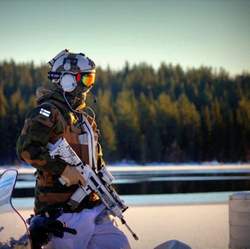
Aquitaynian Special Forces from the 91st Special Infantry Regiment were deployed in 2016 during the Western Tundra Crisis to provide "combat support and deterrence against aggressive Rombergian action in the region." 3rd Battalion was deployed through Thomaion to the Western Tundra and moved inland towards the northern areas of the region to prepare for an assault against a Rombergian-held airfield where supplies were frequently being flown in prior to the establishment of the no-fly zone. These units were re-routed en route to the airfield when an Aquitaynian M.Cs 82 Illusion fighter aircraft went down approximately 30 kilometers from their location, and Operation Pouch was developed. The battalion raced towards the scene of the crash, working to get to the downed pilot before he could be seized by Rombergian forces operating in the area. Around 0400 hours the next morning, the Aquitaynian pilot was secured and, although there was a brief clash with a Rombergian patrol that was forced to surrender to the Aquitaynians, was sent home successfully.
Weeks after the beginning of the conflict, an unnamed source quoted by the Telora Times from inside SOCOM said that PsyOps units were also assigned to target the Rombergian military and civilian news outlets in order to dissuade their resolve in fighting a coalition of TARP and United Kingdom forces, though this claim has never been independently verified.
Today, the 3rd Battalion, 91st Special Infantry Regiment is still deployed to the Western Tundra on a new mission. They are currently operating against the Holy Theocracy of Lorecia, a terrorist organization operating within the Western Tundra. They are also currently being utilized by the coalition for training and support as well as direct action missions. Additional special forces units from the air force and army have also been deployed to the region, with Special Infantry Service soldiers providing training and direction for local secular rebel groups fighting the HTL. Currently, the Ministry of Defense refuses to disclose how many troops are currently deployed to the Western Tundra, but do acknowledge that "troops have been engaged in combat with the Holy Theocracy of Lorecia". The Ministry of Defense has disclosed, additionally, that Aquitaynian Special Forces components of SOCOM are being used for a wide range of special operations capabilities and necessities.
Global presence
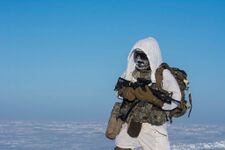
In 2014, Special Operations Command units and or assets were deployed in over 60 countries throughout the world. This is compared to roughly 34 in the beginning of 2003. A SOCOM spokesman was quoted as saying in 2011, just after the South Lorecian War, that "SOCOM hopes to have assets in over 100 countries by the end of 2020, providing a large network of training, capability, and valuable resources." The push for an expansion of SOCOM's reach coincides with a larger expansion of Aquitaynian military presence and power projection throughout Astyria and the rest of the world. Their reach expanded greatly after the 2010 South Lorecian War, where they were vital to the success of the campaigns against Earent. SOCOM has been active in every major conflict in Astyria since then, under the "no war, no questions" motto - an ethos that drives SOCOM to be as informed as possible on every conflict going on not only throughout Astyria, but the world.
Questions have arisen throughout the international community in regards to Aquitayne's legal authority to conduct raids and targeted killings internationally. In 2015, a raid was conducted through Cassonne into Caranad, which targeted and killed Pablo Hernandez, a well known and high-profile cocaine trafficker. Though the international community didn't particularly care about Hernandez's death, concern arose domestically and internationally about the justifications as well as the legality of the raid in question. Additionally, many question the government's authority to conduct any raid in which civilian lives are endangered. This has not, however, deterred SOCOM from acting against accused terrorists across the region. Since 2011, over 3,000 raids - many of which occurred in Pangus or Prudensia - have been conducted throughout the region.
Subordinate commands
Joint Special Operations Command
Army
Marines
Air Force
List of SOCOM Combatant commanders
| No. | Image | Name | Branch | Start of Term | End of Term | Time in office |
|---|---|---|---|---|---|---|
| 1. | 
|
GFM Richard Cassian | HMA | 22 March 1971 | 18 June 1976 | 1,945 days |

